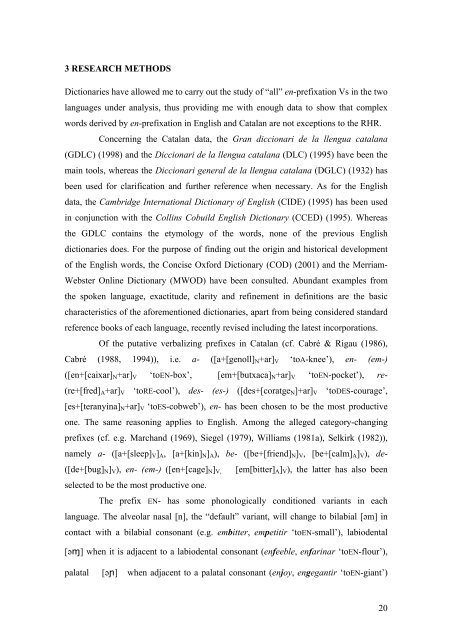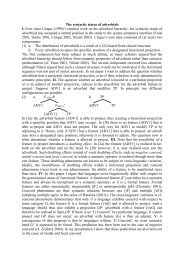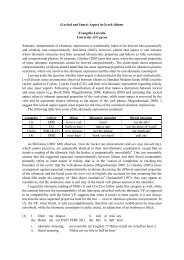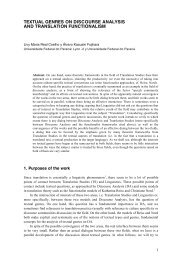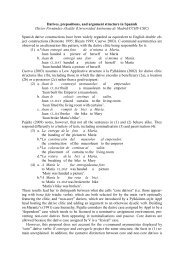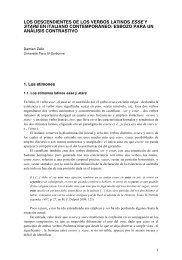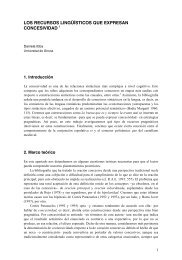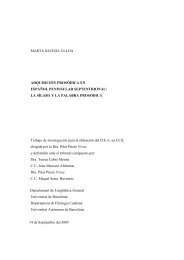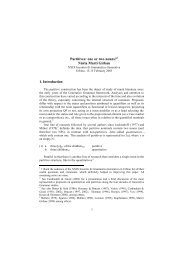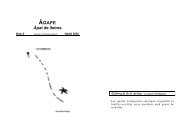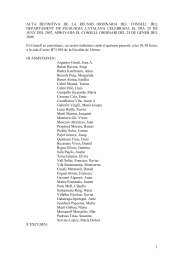Prefixation in English and Catalan - Departament de Filologia ...
Prefixation in English and Catalan - Departament de Filologia ...
Prefixation in English and Catalan - Departament de Filologia ...
You also want an ePaper? Increase the reach of your titles
YUMPU automatically turns print PDFs into web optimized ePapers that Google loves.
3 RESEARCH METHODS<br />
Dictionaries have allowed me to carry out the study of “all” en-prefixation Vs <strong>in</strong> the two<br />
languages un<strong>de</strong>r analysis, thus provid<strong>in</strong>g me with enough data to show that complex<br />
words <strong>de</strong>rived by en-prefixation <strong>in</strong> <strong>English</strong> <strong>and</strong> <strong>Catalan</strong> are not exceptions to the RHR.<br />
Concern<strong>in</strong>g the <strong>Catalan</strong> data, the Gran diccionari <strong>de</strong> la llengua catalana<br />
(GDLC) (1998) <strong>and</strong> the Diccionari <strong>de</strong> la llengua catalana (DLC) (1995) have been the<br />
ma<strong>in</strong> tools, whereas the Diccionari general <strong>de</strong> la llengua catalana (DGLC) (1932) has<br />
been used for clarification <strong>and</strong> further reference when necessary. As for the <strong>English</strong><br />
data, the Cambridge International Dictionary of <strong>English</strong> (CIDE) (1995) has been used<br />
<strong>in</strong> conjunction with the Coll<strong>in</strong>s Cobuild <strong>English</strong> Dictionary (CCED) (1995). Whereas<br />
the GDLC conta<strong>in</strong>s the etymology of the words, none of the previous <strong>English</strong><br />
dictionaries does. For the purpose of f<strong>in</strong>d<strong>in</strong>g out the orig<strong>in</strong> <strong>and</strong> historical <strong>de</strong>velopment<br />
of the <strong>English</strong> words, the Concise Oxford Dictionary (COD) (2001) <strong>and</strong> the Merriam-<br />
Webster Onl<strong>in</strong>e Dictionary (MWOD) have been consulted. Abundant examples from<br />
the spoken language, exactitu<strong>de</strong>, clarity <strong>and</strong> ref<strong>in</strong>ement <strong>in</strong> <strong>de</strong>f<strong>in</strong>itions are the basic<br />
characteristics of the aforementioned dictionaries, apart from be<strong>in</strong>g consi<strong>de</strong>red st<strong>and</strong>ard<br />
reference books of each language, recently revised <strong>in</strong>clud<strong>in</strong>g the latest <strong>in</strong>corporations.<br />
Of the putative verbaliz<strong>in</strong>g prefixes <strong>in</strong> <strong>Catalan</strong> (cf. Cabré & Rigau (1986),<br />
Cabré (1988, 1994)), i.e. a- ([a+[genoll]N+ar]V ‘toA-knee’), en- (em-)<br />
([en+[caixar]N+ar]V ‘toEN-box’, [em+[butxaca]N+ar]V ‘toEN-pocket’), re-<br />
(re+[fred]A+ar]V ‘toRE-cool’), <strong>de</strong>s- (es-) ([<strong>de</strong>s+[coratgeN]+ar]V ‘toDES-courage’,<br />
[es+[terany<strong>in</strong>a]N+ar]V ‘toES-cobweb’), en- has been chosen to be the most productive<br />
one. The same reason<strong>in</strong>g applies to <strong>English</strong>. Among the alleged category-chang<strong>in</strong>g<br />
prefixes (cf. e.g. March<strong>and</strong> (1969), Siegel (1979), Williams (1981a), Selkirk (1982)),<br />
namely a- ([a+[sleep]V]A, [a+[k<strong>in</strong>]N]A), be- ([be+[friend]N]V, [be+[calm]A]V), <strong>de</strong>-<br />
([<strong>de</strong>+[bug]N]V), en- (em-) ([en+[cage]N]V, [em[bitter]A]V), the latter has also been<br />
selected to be the most productive one.<br />
The prefix EN- has some phonologically conditioned variants <strong>in</strong> each<br />
language. The alveolar nasal [n], the “<strong>de</strong>fault” variant, will change to bilabial [əm] <strong>in</strong><br />
contact with a bilabial consonant (e.g. embitter, empetitir ‘toEN-small’), labio<strong>de</strong>ntal<br />
[əɱ] when it is adjacent to a labio<strong>de</strong>ntal consonant (enfeeble, enfar<strong>in</strong>ar ‘toEN-flour’),<br />
palatal [əɲ] when adjacent to a palatal consonant (enjoy, engegantir ‘toEN-giant’)<br />
20


